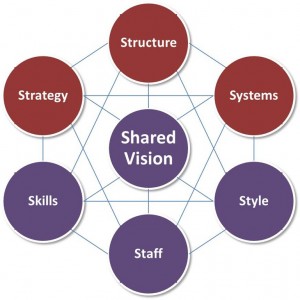The model is based on the theory that, for an organization to perform well, these seven elements need to be aligned and mutually reinforcing. The model can be used to help identify what needs to be realigned to improve performance, or to maintain alignment (and performance) during other types of change.
The 7S are structure, strategy, systems, skills, style, staff and shared values & vision.
The model is most often used as a tool to assess and monitor changes in the internal situation of an organization.
Whatever the type of change – restructuring, new processes, organisational merger, new systems, change of leadership, and so on – the model can be used to understand how the organisational elements are interrelated, and so ensure that the wider impact of changes made in one area is taken into consideration.
Usage
- To analyse how well an organization is positioned to achieve its intended objective
- Improve the performance of a company
- Examine the likely effects of future changes within a company
- Align departments and processes during a merger or acquisition
- Determine how best to implement a proposed strategy
The Seven Interdependent Elements
The basic premise of the model is that there are seven internal aspects of an organization that need to be aligned if it is to be successful
Hard Elements – Strategy, Structure, Systems
Soft Elements – Shared Values, Skills, Staff, Style
The McKinsey 7S Framework is a management model developed by well-known business consultants Robert H. Waterman, Jr. and Tom Peters (who also developed the MBWA– “Management By Walking Around” motif, and authored In Search of Excellence) in the 1980s. This was a strategic vision for groups, to include businesses, business units, and teams.

